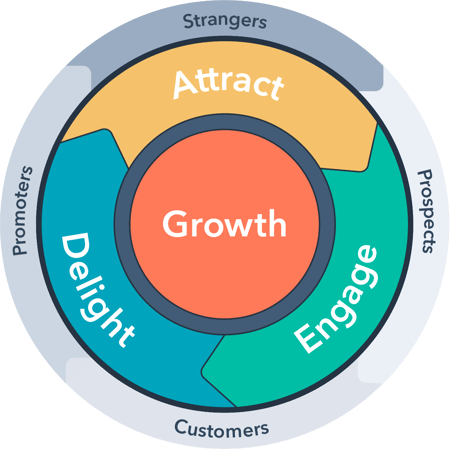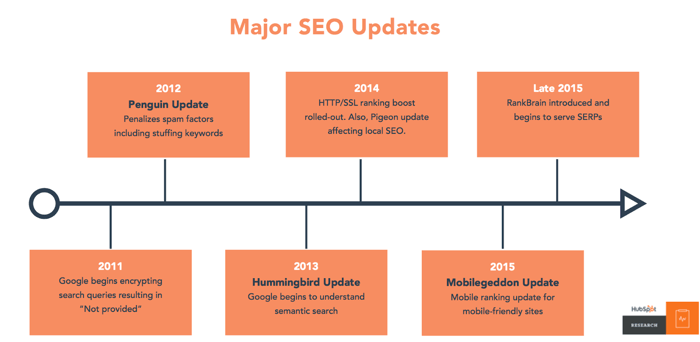If you’re a growth-motivated marketer or business owner who wants to drive more traffic and qualified leads to your website, so you can close more deals faster, you’ve come to the right place.
Part I. What is an SEO content strategy?
Before we can answer that question, we need to answer another question first. How do you know if your SEO content strategy is working?
If you answered, “Our site traffic goes up!” you’re mostly correct. The real secret to a successful SEO content strategy is that it should only bring you more of the right eyeballs to your website – specifically, it should lead your ideal customers to your content at the exact right time.
After that, you’ll be able to convert them, nurture them, and then (fingers crossed) transform them into a buyer – and then it’s customer delight time, folks.
If this is what you’re trying to achieve for your organization through content, you need to beware of most of the piss-poor “definitions” of SEO content strategy that exist out there. What I mean by that is, the last thing you want to do is listen to anyone who tells you that an SEO content strategy is achieved through a single tactic or done with ease overnight.
🔥 Register now: SEO content strategy masterclass (limited seats)
If anyone tells you that, while also making tempting promises of landing on “the front page of Google,” they’re lying to you.
So, what is the real definition of an SEO content strategy?
A successful SEO content strategy that attracts and converts qualified buyers will leverage a blend of strategic activities including knowing what content to create based on your business goals and keyword research, taking that content and optimizing it for search engines effectively, and not undermining your website ranking potential by keeping your technical SEO house in order.
Now, it doesn’t matter if you’re new to content entirely or your company has been creating content for some time – checking off each of those SEO content strategy boxes can feel like quite a mountain to climb:
- If you’re new to content, you’re often overwhelmed by bad advice and misinformation, when all you really need is a clear playbook to help you get started with your SEO content strategy.
- If you’re not new to content, it’s not uncommon to look back and see that you’ve somehow managed to create 536 pieces of content without actually hitting your traffic, leads, or sales goals with any degree of consistency. And that can be pretty freakin’ demoralizing.
If either of those scenarios sounds familiar, I want you to take a deep breath and relax. You are not the first or the last person who will be in your position, so you’re certainly not alone …. and that’s exactly why I created this SEO content strategy guide.
We’re going to make SEO content strategy easy for you
I’ve spent more than a decade working with thousands (yes, thousands!) of marketing professionals and business owners to teach them how to use content to bring more of the right people to their virtual doorstep, so they can achieve their growth goals. And you deserve to see the same level of success that they do.
🎙️ HubHeroes Podcast: What is content strategy? (2023 and beyond)
So, strap in, everybody! Please make sure your arms and legs are inside the SEO content strategy vehicle at all times and that your tray tables are in the upright position as we prepare for takeoff.
Even if you don’t use HubSpot for your marketing, sales, or service automation, you’re still golden. By the end of this guide, you’ll not only understand what an SEO content strategy is, you’ll have a playbook in your hands that will enable you to immediately jumpstart your organization’s strategic content efforts.
Not only that, you’ll be saying to yourself, “Wow, this isn’t as scary or as hard as I thought it was going to be!”
Part II. How search engines like Google rank content
The first building block of your SEO content strategy that we’re going to talk about is creating the right content. Yes, great content strategies will support your entire funnel – not only attracting new leads, but also enabling sales during the closing process.
But developing the content you need to increase website traffic means you are focusing solely on the ATTRACT phase of the process:

Image credit: HubSpot
Ten years ago, figuring out what to write was a bit more of a straightforward process. With a little research and mental elbow grease, you’d come up with a big list of keywords – maybe even hundreds of ‘em – and get to writing in whatever order made the most sense to you.
Heck, you might have even found yourself writing the same article a few times (with slight variations), because there were so many different (yet similar) keywords you wanted to rank for.
This approach does not work anymore.
What’s changed in how Google ranks your website content
As creating content has become more mainstream as a strategy for companies looking to grow, search engines like Google made their algorithms more advanced and sophisticated.
Like you, Google also has customers – everyone who fires up the Google search engine. So, out of necessity, Google has worked tirelessly to change things up with their ranking algorithms to guarantee their customers (which likely includes you) are always served the most relevant and high-quality content that matches exactly what they are looking for.
At the very same time, we humans have become pickier and more demanding about the search results we get from Google.
For example, think about how many times in recent years you’ve searched for something online with the term “near me” included. Even though you’re not telling Google where you are, you expect that Google will be able to figure that out and give you the results you’re looking for, right?
To meet this demand for more relevant content, faster (and with less explicit context), Google has designed its algorithm to be more interested and approving of sites that not only publish high-quality content in a way that’s user-friendly but also do so in a way that makes it easy for the search engine to understand what the heck your website is about.
The folks at HubSpot even created a handy timeline that reviews some of the biggest updates of the past few years:

Image credit: HubSpot
Although even recently (summer 2022), Google has made waves with their Helpful Content Update which outlines explicitly how brands will be rewarded for creating unique, relevant, expertise-laden content … and, more importantly, how they will be actively penalized with diminished rankings if they don’t.
🔥 HubHeroes Podcast: What makes great content GREAT?
That means today if you’re writing up a bunch of hundreds of disorganized blog articles where it’s hard to tell how everything is connected or what big categories you’re trying to own as your areas of expertise, Google will not send you the website traffic you want.
How you need to structure your content strategy today
If we’re all tossing out our endless spreadsheets of disorganized target keywords for blogs, then what the heck are we supposed to put in its place? How can you signal to Google through the content you create what areas of expertise you possess, so they know to tee you up any time one of your ideal buyers comes a-knockin’ for the undeniable industry know-how you possess?
By creating interconnected networks of related content that make it easy for Google, Bing, and others to understand what your website is about.
What I mean by that is:
- What industry you’re in (the expertise)
- Who your ideal target audience is (the searcher)
- How you help them (the substance)
The building blocks for this type of SEO content strategy architecture are called topic clusters and pillar pages. And if you’re wondering what the heck those are, I’ve got good news for you – we’re going to dig into what those mean in the next couple of chapters.
Part III. Topic clusters and pillar pages (a crash course)
Now, some of you may be familiar with these terms. Others of you may not be. Either way, I want to make sure we’re starting this conversation with a shared understanding of what these terms mean, since there can be some confusion.
This is confusion we can’t afford, because topic clusters and pillar pages are the beating heart of how you organize the traffic-driving content for your SEO content strategy.
What is a topic cluster?
A topic cluster in a content strategy is a network of connected content pieces (blogs, videos, podcasts, etc.) that all relate to the same central topic.
🔎 Related: What is a topic cluster? (definition + examples)
Here’s a video for you visual learners out there that is a crash course in topic clusters:



